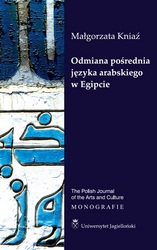
Małgorzata Kniaź, The Intermediate Variety of Arabic in Egypt. Structure and Culture-forming Role [Odmiana pośrednia języka arabskiego. Struktura i rola kulturotwórcza], Uniwersytet Jagielloński, Kraków 2013.
The intermediate variety of Arabic – usually referred to as Educated Spoken Arabic (ESA) or diglossic switching – is created by combining items of Standard and Colloquial Arabic, i.e. the two basic varieties of Arabic. It is not a homogeneous variety but creates a continuum of mixed forms and structures. The intermediate variety is the only natural means of verbal communication in the Arab world in semiformal and formal situations or while conversing with native speakers of different vernaculars. Due to the wide range of applications (including writing), its wide acceptance as a communicative standard and social prestige, the intermediate variety is a key culture-forming element in the Arab world. This book deals with the intermediate variety in Egypt, i.e. based on Egyptian/Cairene Colloquial Arabic.
The book consists of two parts. The first one is devoted to the linguistic situation in Egypt. The starting point is the Fergusonian notion of diglossia, followed by linguistic theories concerning the dichotomy of the Arab world in a historical perspective and the formation of the two main varieties, which now constitute the basis for the intermediate variety – Modern Standard Arabic (MSA) and Cairene/Egyptian Arabic. We discuss the changes that have occurred since the 1950s in the functional distribution of Standard and Colloquial Arabic as well as the factors that led to the dissemination of knowledge and the spread of the intermediate variety; i.e. the development of the state education system, radio and television.
The second part concerns the intermediate variety. Since previous research focuses primarily on selected language items or describe a "model" variety in which literary and vernacular items appear equally, that hardly ever happens in real-life communication, the aim of this book is to present a more complex picture, taking into account the entire continuum on the level of vocabulary, phonology, morphology and syntax. The study is based on data collected from the Egyptian talk-show Al-Mashad, broadcast live by news channel An-Nil.

